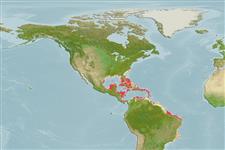>
Kurtiformes (Nurseryfishes, cardinalfishes.) >
Apogonidae (Cardinalfishes) > Apogoninae
Etymology: Phaeoptyx: Greek, phaios = dark + Gree, ptyx, -ikos = fold (Ref. 45335).
Eponymy: Dr Edwin Grant Conklin (1863–1952) was an American biologist, zoologist and embryologist. [...] (Ref. 128868), visit book page.
Environment: milieu / climate zone / depth range / distribution range
Écologie
marin récifal; profondeur 0 - 22 m (Ref. 26938). Tropical
Western Central Atlantic: southern Florida (USA) and Bahamas to northern South America.
Taille / Poids / Âge
Maturity: Lm ? range ? - ? cm
Max length : 9.0 cm SL mâle / non sexé; (Ref. 26938)
Enlarged melanophores that form large stellate or squarish spots, usually more than 1 per scale below lateral line (Ref. 26938). Vertically elongate blackish blotch at caudal fin base (Ref. 13442).
Commonly found on shallow rocky and coral bottoms (Ref. 9626), in empty conch shells, rubble, or empty containers. Abundant where Acropora palmata abound (Ref. 9626). Oviparous (Ref. 205). Presence of buccal pouch for brooding eggs (Ref. 39366).
Life cycle and mating behavior
Maturité | Reproduction | Frai | Œufs | Fécondité | Larves
Are mouthbrooders (Ref. 240, 58878). Spawning may occur throughout the year (Ref. 39366). Distinct pairing during courtship and spawning (Ref. 205).
Robins, C.R. and G.C. Ray, 1986. A field guide to Atlantic coast fishes of North America. Houghton Mifflin Company, Boston, U.S.A. 354 p. (Ref. 7251)
Statut dans la liste rouge de l'IUCN (Ref. 130435: Version 2024-1)
Menace pour l'homme
Harmless
Utilisations par l'homme
Outils
Articles particuliers
Télécharger en XML
Sources Internet
Estimates based on models
Preferred temperature (Ref.
123201): 25.4 - 28.2, mean 27.4 °C (based on 719 cells).
Phylogenetic diversity index (Ref.
82804): PD
50 = 0.6250 [Uniqueness, from 0.5 = low to 2.0 = high].
Bayesian length-weight: a=0.01096 (0.00509 - 0.02362), b=3.09 (2.91 - 3.27), in cm total length, based on LWR estimates for this (Sub)family-body shape (Ref.
93245).
Niveau trophique (Ref.
69278): 3.5 ±0.5 se; based on size and trophs of closest relatives
Résilience (Ref.
120179): Haut, temps minimum de doublement de population inférieur à 15 mois (Preliminary K or Fecundity.).
Fishing Vulnerability (Ref.
59153): Low vulnerability (10 of 100).
Nutrients (Ref.
124155): Calcium = 146 [88, 267] mg/100g; Iron = 1.01 [0.61, 1.61] mg/100g; Protein = 19 [18, 20] %; Omega3 = 0.166 [0.101, 0.276] g/100g; Selenium = 25.9 [13.6, 48.0] μg/100g; VitaminA = 106 [38, 298] μg/100g; Zinc = 2.06 [1.40, 2.92] mg/100g (wet weight);
